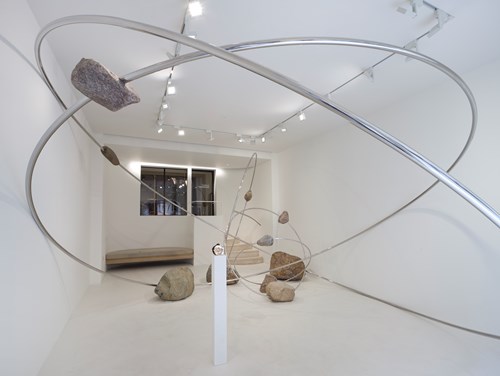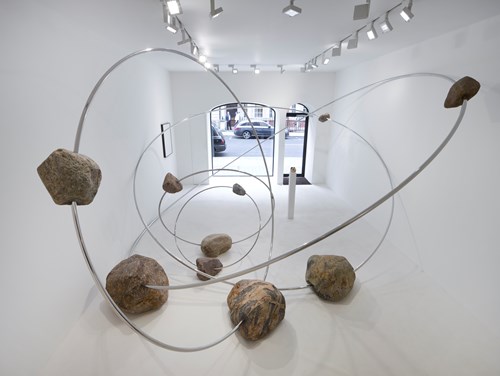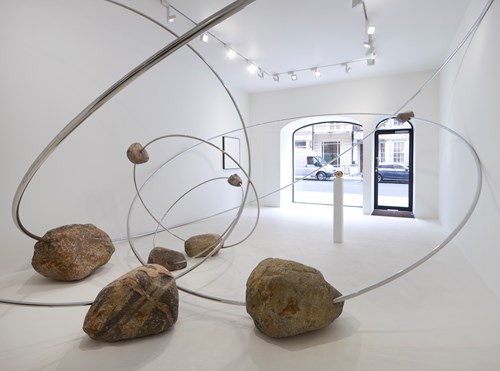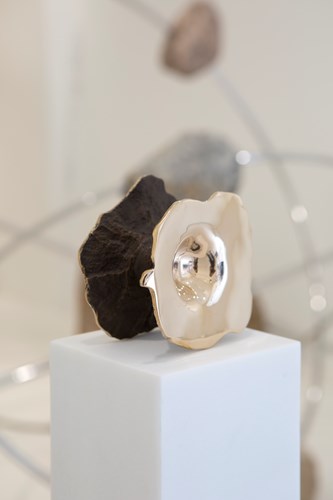“I am probably dealing with the same questions as philosophers, but we express ourselves in a different language.” An Interview with Alicja Kwade

Born in Poland and now working in Berlin, Alicja Kwade creates thought-provoking works that seem to question the very barriers of our material world and our relationship to space and the unknown entities of the universe. Working primarily in sculpture but also willing to foray into installation, video or photography if it helps to explore her themes, she has gained a reputation as an artist who is on a quest explore the very fabric and materials of our universe. Artdependence caught up with her to find out more about her philosophy and her inspirations.
Born in Poland and now working in Berlin, Alicja Kwade creates thought-provoking works that seem to question the very barriers of our material world and our relationship to space and the unknown entities of the universe. Working primarily in sculpture but also willing to foray into installation, video or photography if it helps to explore her themes, she has gained a reputation as an artist who is on a quest explore the very fabric and materials of our universe.
Artdependence caught up with her to find out more about her philosophy and her inspirations.
Artdependence Magazine: Would you say you are a philosopher? Your "moto" is “I’m trying to see what reality is for me, and what it is for us all." It is reminiscent of Descartes' Cogito ergo Sum, ‘I think therefore I am’.
Alicja Kwade: I don’t follow a “motto” as such and I would not call myself a philosopher. I am an artist who uses philosophy as a source. I am probably dealing with the same questions as philosophers, but we express ourselves in a different language.
AD: You have stated that you are fascinated with the borders between science and suspicion. Can you explain this?
AK: I am interested in this topic, but the word “suspicion” is not defined enough. I am more interested in social agreements, adopted facts and where they come from. I am interested in hypotheses, declaration models and their constituent parts.

Alicja Kwade. OrbitaGravitas, 2017. Acier inoxydable, pierres / Stainless steel, boulders. Dimensions variables / Variable dimensions. Urknall, 2017, Bronze. 11 x 11 x 6 cm. Candle Column (Selfportrait), 2017. Bronze. 164 x 10 cm. Vue de l’exposition / View of the exhibition « Revolution Orbita », kamel mennour (51 Brook Street), Londres, 2017. © Alicja Kwade. Photo. archives kamel mennour. Courtesy the artists and kamel mennour, Paris/London

Alicja Kwade. OrbitaGravitas, 2017. Acier inoxydable, pierres / Stainless steel, boulders. Dimensions variables / Variable dimensions. Ein Monat (August 2017), 2017. Aiguilles de montres à gousset sur carton / Pocket watchs hands on cardboard. 81 x 72,6 cm. Urknall, 2017. Bronze. 11 x 11 x 6 cm. Vue de l’exposition / View of the exhibition « Revolution Orbita », kamel mennour (51 Brook Street), Londres, 2017. © Alicja Kwade. Photo. archives kamel mennour. Courtesy the artists and kamel mennour, Paris/London



Alicja Kwade. OrbitaGravitas, 2017. Acier inoxydable, pierres / Stainless steel, boulders. Dimensions variables / Variable dimensions. Ein Monat (August 2017), 2017. Aiguilles de montres à gousset sur carton / Pocket watchs hands on cardboard. 81 x 72,6 cm. Urknall, 2017. Bronze. 11 x 11 x 6 cm. Vue de l’exposition / View of the exhibition « Revolution Orbita », kamel mennour (51 Brook Street), Londres, 2017. © Alicja Kwade. Photo. archives kamel mennour. Courtesy the artists and kamel mennour, Paris/London
AD: Are your works tromp d'oeil, surrealism or more like realism?
AK: Neither the one or the other. Those are all defined historical art directions. I use parts of their language but hopefully I create something new. I am not interested in one particular technique such as the tromp d’oeil.
AD: Your work entitled ‘Hypothetisches Gebilde’ (2015) is a sculpture about wormholes. It seems to suggest that sound is everywhere in space and cannot be escaped. How important is space in your work?
AK: Sound is the vibration of atoms in the air. Vibration is matter, as we assume from string theory. This is what interests me. There is actually no sound in space, just silence. Yes, of course these works are playing with the thoughts and associations of instruments and sounds, but for me it is more about waves, vibrations and matter.
AD: Is Duchamp an influence for you or more of an example?
AK: There is no way not to be influenced by Duchamp. No, this is not an example, we have to get further.
AD: What is the theme of your upcoming exhibition, Revolution Orbita? We understand the words ‘Revolution’ and ‘Orbita’. What do they mean stitched together?
AK: Revolution means ‘turn’ in Latin. For me, it´s a sentence expressing ‘revolution’, which can and is done constantly by us humans - learning new things and discarding old ideas. But it’s also a term for a circular movement as well as standing for change, but in a circular, repetitive way. We can hardly escape our orbit of opinions and options.

Alicja Kwade. OrbitaGravitas, 2017. Détail / Detail. Acier inoxydable, pierres / Stainless steel, boulders. Dimensions variables / Variable dimensions. Urknall, 2017. Bronze. 11 x 11 x 6 cm. Vue de l’exposition / View of the exhibition « Revolution Orbita », kamel mennour (51 Brook Street), Londres, 2017. © Alicja Kwade. Photo. archives kamel mennour. Courtesy the artists and kamel mennour, Paris/London

Alicja Kwade. Ein Monat (August 2017), 2017. Aiguilles de montres à gousset sur carton / Pocket watchs hands on cardboard. 81 x 72,6 cm. Vue de l’exposition / View of the exhibition « Revolution Orbita », kamel mennour (51 Brook Street), Londres, 2017. © Alicja Kwade. Photo. archives kamel mennour. Courtesy the artists and kamel mennour, Paris/London
